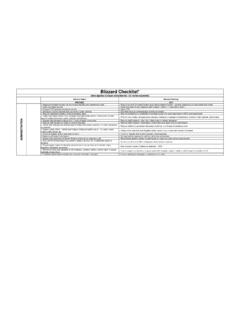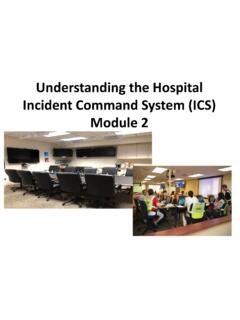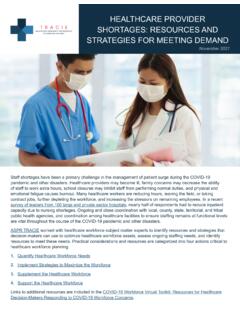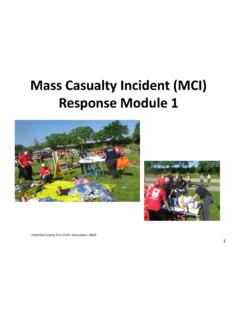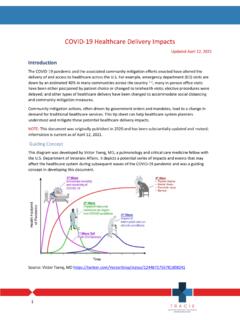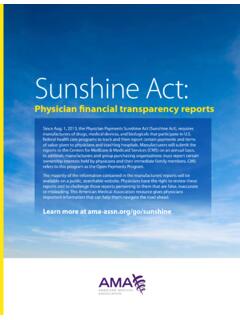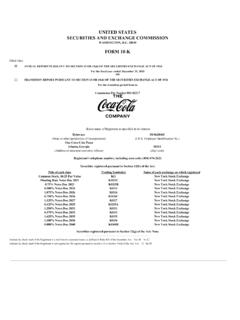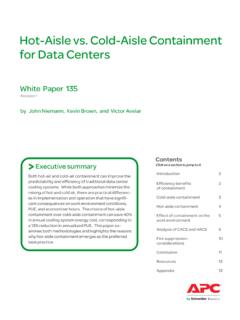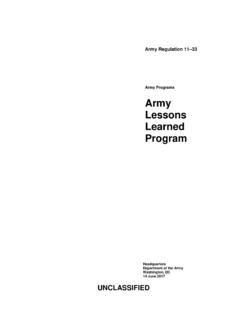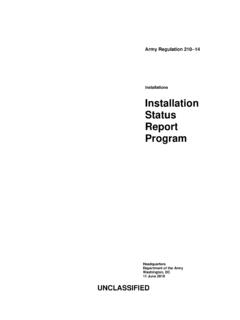Transcription of COVID-19 AND URGENT CARE CENTERS
1 COVID-19 AND URGENT care CENTERSL essons Learned for the FutureAs the COVID-19 pandemic raged across the , local community URGENT care CENTERS were often on the frontlines. ASPR TRACIE met with incoming Chief Executive Officer (CEO) Lou Ellen Horwitz, outgoing CEO Laurel Stoimenoff, and Chief Development Officer Kim Youngblood (who also leads the URGENT care Foundation) from the URGENT care Association (UCA) to learn more about their experiences, lessons learned, and plans to work with their local medical communities in the near future. John Hick (JH)Tell us about URGENT care CENTERS and the association. For example, how many URGENT care CENTERS are there in the Lou Ellen Horwitz (LH)Founded in 2004, UCA is the largest association in the country representing the interests of the URGENT care industry. Our membership includes both organizations and individuals, representing approximately 4,000 CENTERS . We estimate that there are 9,600 URGENT care CENTERS across the and though there are a variety of models, they must all meet certain criteria, especially to be accredited.
2 Our members diagnose and treat a wide range of illness and injury in individuals of all ages. Our services are typically broader than retail (drugstore) clinics or primary care offices, but not as broad as an emergency department (ED). Our walk-in accessibility and lower cost than the ED make us ideal for urgently needed testing and diagnosis such as we ve experienced with COVID-19 . Laurel Stoimenoff (LS)While our CENTERS treat more than 160 million patients each year, the majority present with lower-acuity, community-acquired, infectious disease-related symptoms. UCA also works very closely and collaborates with the Convenient care Association, the organization that represents retail clinics. There are about 3,300 retail health clinics in the country, and while we share a high degree of accessibility and there is some overlap with the services provided by retail clinics, URGENT care CENTERS are prepared to treat higher-level acuity patients because of on-site lab and x-ray capabilities.
3 Our CENTERS are located in every area of the country from large urban areas to rural communities where they are often the sole primary care providers. Kim Youngblood (KY)The URGENT care Foundation (UCF) is an affiliate of the URGENT care Association and its mission is to serve the URGENT care industry in the areas of research, education, clinical and practice management leadership, as well as innovation in new and emerging healthcare delivery models. The Foundation is very interested in partnering with ASPR TRACIE since emergency preparedness is of critical importance to our members and the industry. In fact, we initially launched an Emergency Preparedness Initiative to assist our members with Hurricane Harvey relief efforts and over the past several years, we have expanded our work in this area by leading initiatives to fund education and training for clinicians including our most recent efforts to support the URGENT care industry with our COVID-19 Emergency Fund. JHHow have things shifted since the 2009 H1N1 pandemic?
4 LHThe main lesson learned from H1N1 was that we had not set up adequate connections between state-based resources and URGENT care CENTERS . At that time, our industry was still relatively new and more fragmented and we did not have the bandwidth to conduct more expansive outreach. That has changed over the past decade and now URGENT care CENTERS are located in every area of the country and our efforts are more coordinated. UCA has mapped URGENT care CENTERS and they can be easily located by visiting our website. We ve also had time to build relationships, such as the one with ASPR TRACIE. While we definitely learned some valuable lessons on emergency preparedness after the H1N1 pandemic, I think we all fell into the trap of getting busy with our next initiatives and neglecting to really solidify the connective pathways so we could be better prepared for the next emergency. In fact, last year I presented on an ASPR TRACIE panel, and while our industry has matured, and our numbers grown significantly, we still had members in the audience unaware of the availability and accessibility of URGENT care .
5 We have more work to do so our fellow healthcare leaders fully understand our capabilities. They do not have to recreate the wheel in a pandemic situation like COVID-19 as we have already built it and are ready to roll. JHWhat are the key issues facing URGENT care CENTERS amid COVID-19 ? LSThe COVID-19 pandemic has changed our industry. As an organization, UCA had to quickly respond and address the needs of our members. Some of the first positive COVID-19 patients presented at several URGENT care CENTERS in New York City. While most CENTERS have emergency response plans as a result of previous pandemics such as seasonal influenza, HIV, and H1N1, the healthcare community, like most of the world, was not prepared for COVID-19 . As a result, UCA redirected its activities and dedicated one of our listservs solely to COVID-19 to provide a forum for the exchange of clinical and operational information regarding preparedness and testing. For the most part, discussions focused on the clinical side.
6 Our members were thankful for this platform, since the pandemic created unique new challenges around testing, PPE shortages, patient safety, and protecting staff from a novel infectious disease all while managing the drop off in patient volume and furloughing employees. Another challenge our members faced was being able to message communities and the field at large about their capabilities. We remain relatively fragmented, and while CENTERS were perfectly capable of running the testing process, for example, they were not always seen as an option because many planners do not understand the varied scopes of practice. This led to the creation of a COVID-19 centralized database to ensure that patients and the public health community understood our full capacity to provide testing. We have canvassed our members to note specific testing capabilities ( , PCR or antibody testing for COVID-19 ). We created this database in direct response to media and state departments of health inquiries regarding center capabilities.
7 This will also allow us to quickly assess the number of URGENT care CENTERS that are equipped to provide COVID-19 vaccines when they are available. JHEarly on, we were prohibited from taking COVID-19 test samples unless we were in an airborne isolation room, which most URGENT care CENTERS do not have. Then, that guidance was modified. As the landscape shifts, and guidance is modified, how do you adjust to these changes? LHWe can move quickly, make changes, and adapt to different situations in URGENT care . Walk-in medicine teaches you to embrace change on day one. We are an industry that is both proactive and consumer responsive, so as COVID-19 evolves, so will our members. LSIn the beginning of the pandemic when guidance was very limited, one of our most respected clinicians noted on the listserv that URGENT care CENTERS are not the appropriate sites for testing. We don t have enough personal protective equipment (PPE), and we should be making referrals. To which many members replied, indicating that they are the only sources of medical care in their areas and we needed to figure out how to provide testing.
8 So, they went to work to develop protocols and source the needed supplies. We ve surveyed our members every two weeks, and at first, only 30-40% were able to test for COVID-19 (many did not have access to PPEor testing kits). Now, 90% of our members have a mechanism forconducting some form of COVID-19 testing (PCR and/ or antibody). Thetime to get a test result has shortened as will forever change how we respond to pandemics, and we will emerge from this crisis as a better industry and organization, forward thinking and Laurel Stoimenoff JHTell us more about PPE challenges, from a programmatic and supply perspective. LSHistorically, patients with infectious diseases ( , measles and influenza) visit URGENT care CENTERS to receive a diagnosis and treatment; URGENT care CENTERS are currently testing a disproportionate share of COVID-19 patients. From an accreditation perspective, we ensure members have procedures in place if there is some type of exposure, but for the most part, we do not have the in-room ventilation capabilities.
9 There are some exceptions, such as those clinics created by converting an old ED. Our members were desperate for PPE in the beginning. About 10% of the industry was responding to our weekly surveys that they could not get basic surgical masks or gowns, and N95 masks were almost impossible to find. It has been a challenge to the entire health care industry and inexplicably URGENT care CENTERS are often very far down the PPE distribution list. In Pennsylvania, for example, URGENT care CENTERS were down in group 3, despite being on the front line of the pandemic. EDs were in group 1. JHWhat proportion of CENTERS routinely used N95 prior to COVID-19 ? What other types of PPE are used? LHI came from a large health system with over 40 URGENT care CENTERS , and we didn t use them routinely in any of our CENTERS , so it is very uncommon. When the COVID-specific guidance about masks initially came out, there was an enormous reaction and rush to get them, but within a couple of weeks, that guidance changed, too.
10 I would assume most URGENT cares have gone back to their regular level of PPE and are using more face shields than used to be routine. Workflow changes that conserved PPE and kept people from coming in before being screened have also been implemented. Use of telemedicine has also helped with that in many CENTERS . JHHow has provision of care changed since COVID-19 , especially regarding screening? LSThere are quite a few best practices emerging now; some screen patients in parking lots, others post messaging on their websites, instructing patients to call ahead if they have any symptoms. Other practices include bringing suspected patients in through the back door, separating sick from well patients in reception, and isolating rooms for two hours if a suspected case was treated within. We worked with the American College of Emergency Physicians to develop risk stratification and decide when to send a patient to the emergency department. We are currently working on pediatric risk stratification data.


